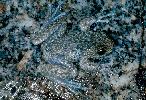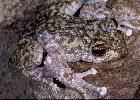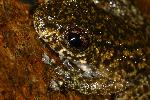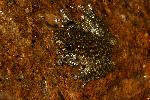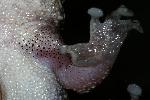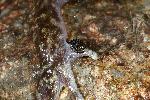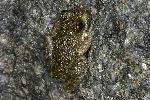Species profile—Litoria nannotis (waterfall frog)
Classification
Animalia (animals) → Amphibia (amphibians) → Hylidae (tree frogs) → Litoria nannotis (waterfall frog)

Go to Photo gallery
Sighting data
Species details
- Kingdom
- Animalia (animals)
- Class
- Amphibia (amphibians)
- Family
- Hylidae (tree frogs)
- Scientific name
- Litoria nannotis (Andersson, 1916)
- Common name
- waterfall frog
- Type reference
- Andersson, L.G. (1916). Results of Dr. E. Mjoberg's Swedish Scientific Expeditions to Australia 1910-1913. 9. Batrachians from Queensland. K. Svenska Vetensk.-Akad. Handl. (ns) 52: 1-20 [16 figs 5a-e].
- WildNet taxon ID
- 603
- Synonym(s)
- Dryopsophus nannotis
Ranoidea nannotis - Alternate name(s)
- torrent frog
torrent treefrog - Nature Conservation Act 1992 (NCA) status
- Endangered
- Conservation significant
- Yes
- Wetland status
- Wetland Indicator Species
- Endemicity
- Native
- Pest status
- Nil
- Description
- The waterfall frog is a moderately large, robust species. The back is slate, olive or dull brown in colour, with irregular dark mottling. The belly is white or cream in colour, often with brown on the throat. The axilla (armpit) and groin are flesh coloured. The skin is shagreened, finely granular, or with numerous small scattered warts above, granular below. The fingers have basal webbing, and the toes are fully webbed. The finger and toe discs are well developed. Males have a large prepollex (expanded thumb), with black spiny nuptial pads and accessory spines on the chest, head, forearm and thighs. There is no vocal sac. The snout is bluntly rounded, and the tympanum (eardrum) is indistinct. Male SVL ranges from 31.6-52.1mm and weight from 4.2-12g, while female SVL ranges from 48.2-59mm and weight from 7.2-16g. (Liem 1974; Cogger 1994; McDonald & Alford 1999).
The call has been described as a repeated "crawk crawk crawk" or a gentle, popping, slow growl-like sound that is difficult to hear above the sound of flowing water (McDonald 1992; Richards 1993).
The tadpoles are adapted for fast flowing stream conditions with suctorial mouth, muscular tail, narrow tail fins and ventro-lateral spiracle. The body colour is grey or olive-green with a dark abdomen, yellowish tail, and numerous diffuse dark-brown blotches across the tail muscle and fins. The oral disc is surrounded by marginal and submarginal papillae, and has two anterior tooth rows, and three posterior (Liem 1974; Richards 1992). - Map
- View Map
- Distribution
- Formerly occurred throughout the Wet Tropics between Paluma, north of Townsville and Mungumby Creek, 30km south of Cooktown at elevations from 80-1300m. Significant population declines in upland populations have occurred since 1990, and the species is now largely absent from sites above 400m. (McDonald 1992; NQTFRT 2001).
- Distributional limits
- -15.7066666, 145
-19.1138889, 146.3719444 - Range derivation
- Range derived from extent of the taxon's confirmed records
- Species environment
- Aquatic & Terrestrial
- Habitat
- This species inhabits fast-flowing streams around waterfalls and cascades in rainforest from 80-1300m above sea level. They are generally found on boulders beside or behind waterfalls and cascades, but may be perched on trees or litter beside streams in moist conditions. Tadpoles are usually found in fast flowing sections of the stream, attached to rocks. (Liem 1974; McDonald 1992; Richards 1992; Martin & McDonald 1995).
- Home range
- Waterfall frogs move little during the day, but regularly travel away from the stream at night, moving up to 35m from the stream before returning to the stream the same night (Hodgkison & Hero 2001; Rowley & Alford 2007).
- Burrows and nests
- None
- Behaviour
- The waterfall frog is primarily nocturnal, sheltering in refuges behind waterfalls or between in-stream rocks during the day from which they occasionally emerge to bask in the splash zone. Several animals may aggregate in these diurnal refuges. At night they are much more active, being found in exposed positions within streams and streamside vegetation up to 35m from the stream. Males may engage in foot-flagging displays. (Liem 1974; Richards & James 1992; Hodgkison & Hero 2001; Rowley & Alford 2007).
- Reproduction
- Gravid (pregnant) females are encountered year round, as are males with nuptial pads. 136-216 large unpigmented eggs measuring 1.98-3.4mm in diameter are layed as a gelatinous clump under rocks in streams. (Liem 1974; Martin & McDonald 1995; Hero & Fickling 1996).
- Diet
- Adults feed on a wide range of terrestrial and aquatic invertebrates including flies, dragonflies, beetles, bugs, cockroaches, ants & millipedes. The tadpoles graze on algal-covered rocks in fast flowing stream conditions. (Cogger et al. 1983; Martin & McDonald 1995; Hodgkison & Hero 2003).
- Parasites and pathogens
- The waterfall frog is susceptible to chytridiomycosis, a fatal disease of amphibians caused by the fungus Batrachochytrium dendrobatidis. This species is also parasitized by larvae of a Dipteran fly (Batrachomyia sp.). (Berger et al. 1999; McDonald & Martin unpublished data).
- Threatening processes
- The causes of the decline remain unknown. There is no obvious evidence that drought, floods, habitat destruction, UB-V radiation or pollution by pesticides, inorganic ions or heavy metals were responsible for the population declines. Current research is examining the possibility that a disease may have caused the decline of this species. (Richards et al 1993; NQTFRT 2001).
- Status notes
- Litoria nannotis is one of seven species of frogs occurring in the upland rainforest streams which have undergone substantial population declines in north-eastern Queensland. Since 1990 population declines or local extinctions have been noted at upland sites throughout the Wet Tropics Biogeographical Region, and the species is now absent from most upland sites. (Richards et al 1993; NQTFRT 2001).
- Management documents
- Tyler, M.J. (1997). The Action Plan for Australian Frogs. Environment Australia, Canberra.
NQTFRT (2001). Recovery plan for the stream-dwelling rainforest frogs of the Wet Tropics biogeographic region of north-east Queensland 2000-2004. Report to Environment Australia, Canberra. QPWS, Brisbane.
AGDEH (2006). Threat Abatement Plan for infection of amphibians with chytrid fungus resulting in chytridiomycosis. Department of the Environment and Heritage, Canberra. - Management recommendations
- 1. Assess and monitor populations.
2. Investigate disease as a threatening factor.
3. Translocate and reintroduce species on an adaptive management basis.
4. Clarify the needs of the species.
5. Inform and involve the public in the recovery of species.
6. Ensure frog needs are considered in relevant land management decisions.
(NQTFRT 2001). - Notes
- Contributors: Wayne E. Martin 17/07/1997; David McFarland 26/10/2007; Danielle Hansen 16/01/2009; Wayne E. Martin 27/01/2009
- References
- Berger, L., Speare, R. & Hyatt, A. (1999). Chytrid fungi and amphibian declines: overview, implications and future directions. Pp 23-33. in A. Campbell (ed), Declines and Disappearances of Australian frogs. Environment Australia, Canberra. 234 pp.
Cogger, H.G. (1994). Reptiles and Amphibians of Australia. Reed Books, Sydney.
Cogger, H.G., Cameron, E.E. & Cogger, H.M. (1983). Zoological Catalogue of Australia. Vol. 1 Amphibia and Reptilia. Australian Government Publishing Service, Canberra.
Hero, J.-M. & Fickling, S. (1996). Reproductive characteristics of female frogs from mesic habitats in Queensland. Memoirs of the Queensland Museum 39, 306.
Hodgkison, S. & Hero, J-M. (2001). Daily behaviour and microhabitat use of the Waterfall Frog, Litoria nannotis in Tully Gorge, eastern Australia. Journal of Herpetology 35, 116-120.
Hodgkison, S. & Hero, J-M. (2003). Seasonal, sexual and ontogenetic variations in the diet of the 'declining' frogs Litoria nannotis, Litoria rheocola and Nyctimystes dayi. Wildlife Research 30, 345-354.
Ingram, G.J. & McDonald, K.R. (1993). An update on the decline of Queensland's frogs. Pp 297-303 in D. Lunney and D. Ayers (eds), Herpetology in Australia. A diverse discipline. Royal Zoological Society of New South Wales, Mosman. 414pp.
Liem, D.S. (1974). A review of the Litoria nannotis species group and a description of a new species of Litoria from north-east Queensland, Australia. Memoirs of the Queensland Museum 17(1), 151-168.
Martin, W.E. & McDonald, K.R. (1995). Draft Recovery Plan for the Threatened Stream-dwelling Frogs of the Wet Tropics. Queensland Department of Environment and Heritage, Brisbane.
McDonald, K.R. (1992). Distribution patterns and conservation status of north Queensland rainforest frogs. Conservation Technical Report 1. Queensland Department of Environment and Heritage, Brisbane.
McDonald, K.R. & Alford, R.A. (1999). A Review of Declining Frogs in Northern Queensland. Pp 14-22 in A. Campbell (ed), Declines and Disappearances of Australian Frogs. Environment Australia, Canberra. 234 pp.
Northern Queensland Threatened Frogs Recovery Team (NQTFRT) (2001). Recovery plan for the stream-dwelling rainforest frogs of the Wet Tropics biogeographic region of north-east Queensland 2000-2004. Report to Environment Australia, Canberra. Queensland Parks and Wildlife Service, Brisbane.
Richards, S.J. (1992). The tadpole of the Australian frog Litoria nyakalensis (Anura, Hylidae), and a key to the torrent tadpoles of northern Queensland. Alytes 10(3), 99-103.
Richards, S.J. (1993). A guide to the identification of declining frogs and their tadpoles in the Wet Tropics Biogeographic Region, Queensland. Unpublished Report QDEH
Richards, S.J., McDonald, K.R., Alford, R.A. (1993). Declines in populations of Australia's endemic tropical rainforest frogs. Pacific Conservation Biology 1, 66-77.
Rowley, J.J.L. & Alford, R.A. (2007). Movement patterns and habitat use of rainforest stream frogs in northern Queensland, Australia: implications for extinction vulnerability. Wildlife Research 34, 371-378. - Profile author
- Wayne E. Martin (27/01/2009)
Other resources
Data source
This profile data is sourced from the QLD Wildlife Data API using the Get species by ID function used under CC-By 4.0.
https://apps.des.qld.gov.au/species/?op=getspeciesbyid&taxonid=603.
This information is sourced from the WildNet database managed by the Queensland Department of Environment and Science.


